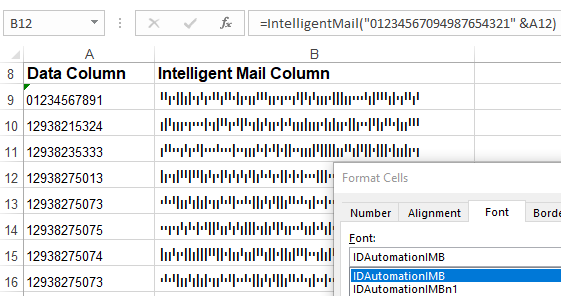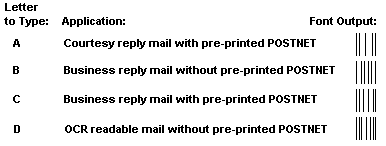
Implementing solutions with IDAutomation's postal fonts provides a high level of scalability with operating system, application and printer independence. Learn more about the quality of these fonts.
The postal fonts that are provided, such as OCR-A and
FIM, are easy-to-use. However, barcode fonts such as Intelligent
Mail IMb, Postnet and
Planet require a "check-digit"
calculation, which can be automatically generated with the
royalty-free font
tools. IDAutomation also offers
Barcode Components
that print barcodes as images and automatically calculate the required
check digits. These components include
ActiveX
Controls,
.NET DLLs,
ASP Components,
Web Controls and
Java
Components, in addition to native generators for
Access,
Crystal Reports,
JavaScript and
Oracle.
 The
POSTNET (POSTal Numeric Encoding Technique) barcode font is a special
font developed to encode zip code information. POSTNET bar codes on US mail
improve the speed, accuracy and delivery of mail. Some USPS Offices also
offer a discount for sending bulk mail when using the POSTNET barcode on
U.S. mail. However, the USPS plans to require the
Intelligent Mail barcode to qualify for automation discounts beginning
in January of 2009. Intelligent Mail is a barcode type coined by the
United Stated Postal Service (USPS) that is used to track and sort
letters and flat packages.
The
POSTNET (POSTal Numeric Encoding Technique) barcode font is a special
font developed to encode zip code information. POSTNET bar codes on US mail
improve the speed, accuracy and delivery of mail. Some USPS Offices also
offer a discount for sending bulk mail when using the POSTNET barcode on
U.S. mail. However, the USPS plans to require the
Intelligent Mail barcode to qualify for automation discounts beginning
in January of 2009. Intelligent Mail is a barcode type coined by the
United Stated Postal Service (USPS) that is used to track and sort
letters and flat packages.
For this reason, IDAutomation has implemented unique encoding in IDAutomation's Postnet Fonts, which allow printing of Postnet, Planet and Intelligent Mail with the same barcode font, to meet the requirements today with support for the needs of tomorrow.
The Postnet Font Package also includes the USPS Special Services Font for EAN128 & GS1-128. GS1-128 (previously known as UCC-128 and EAN-128) is defined by GS1 and used to create several types of barcode symbols that include Application Identifiers. The IDAutomationC128L font, when printed at 16 points, will produce the exact dimensions for GS1/UCC/EAN Code 128 required by the USPS special services, which is a height of .75" and an X dimension of .013". For information about formatting USPS UCC/EAN128 barcodes with IDAutomation's products, refer to the USPS portion of the Code 128 FAQ.
All Postnet Fonts require special formatting so that the data, when the barcode font is applied, will be scannable. Over 30 royalty free font tools, macros and plug-ins are provided to complete this automatically.
PLANET is a barcode that will track both inbound and outbound letter mail. The PLANET bar codes complement the existing POSTNET barcodes and look very similar. The PLANET barcodes are required by the U.S. Post Office to use their CONFIRM service. CONFIRM provides confirmation that customers received the mail, allowing mailers to synchronize telemarketing programs with direct mail campaigns or augment other advertising media with their mailings.

The FIM (Facing Identification Mark) font is a special font used by the U.S. Post Office to separate business reply mail from other mail.
IDAutomationFIM" font consists of four unique bar codes; each barcode represents a unique reply mail classification as defined in the graphic image.
Intelligent Mail is the USPS implementation of the 4-State Customer Barcode type in the United States. Other implementations of the 4-State Customer Barcode exist in other countries such as RM4SCC, which are described below. The primary purpose of Intelligent Mail is to combine the zip code data of Postnet and the tracking of Planet into a single barcode symbol with additional data as described in the Intelligent Mail FAQ and Tutorial.
OneCode & Intelligent Mail symbols may also be generated online for testing purposes.
The Royal Mail created the first 4-state barcode referred to as the "Royal Mail 4 State Customer Code" (RM4SCC). It is used for automated mail sortation processes. This barcode is now used in several countries to print the postcode and Delivery Point Suffix (DPS) on letters in machine readable format. The Dutch KIX barcode is an implementation of the same 4-state bar code.
The RM4SCC barcode is based on 36 barcodes representing alpha-numeric characters (0-9, A-Z) as well as start and stop bar characters which are represented by ( and ). It is called "4-state" because the bars in the barcode can be grouped in 4 different ways to represent alpha-numeric data. The RM4SCC barcode can be printed from IDAutomation's fonts by sending the appropriate character to the printer with the "IDAutomationRM" font selected. Font automation tools have been created to assist users in calculating check digits for the RM4SCC 4-state barcode.
The Australian Post Address barcode is another implementation of the same 4-State barcode. However, their implementation uses different encoding tables than the RM4SCC barcode to encode 64 different barcodes in the "C Encoding Table" and 10 in the "N Encoding Table". They also use Reed Solomon error checking instead of a single check character. Reed Solomon is an error correction that allows the symbol to endure some damage without causing loss of data.
The Australia Post Address barcode can be printed from IDAutomation's fonts by sending the appropriate bar state value for each bar of the character to the printer with the "IDAutomation4STATE" font selected. For example, to produce the character "H" under the "C Encoding Table", the numbers "012" would need to be sent to the printer. To produce the number "7" under the "N Encoding Table", the numbers "21" would need to be sent to the printer.
At the Future Post website, they provide a guide to print the 4-State Australia Post Address barcode which will provide the encoding tables needed and Visual Basic programming code for calculating the Reed Solomon error correction.
Custom implementations of the 4-state barcode may be easily produced with IDAutomation's fonts. The character above the barcode sample in the chart below is the character to print that will produce the bar pattern with the appropriate font selected.
| Font Used | Tracker, Ascender & Descender |
Tracker & Ascender |
Tracker & Descender |
Tracker | |||
| IDAutomation4STATE | 0 | 1 | 2 | 3 | |||
| IDAutomationPOSTNET | p | q | r | s | |||
| IDAutomationPOSTNET | F | A | D | T | |||
OCR-A fonts are used for better character recognition at post offices that have new advanced optical character recognition systems. These systems can decode the characters in the address without error because they conform to the ISO standard. One example is the OCR-A font that is used occasionally on U.S. mail with the FIM-D barcode symbol.
To help users integrate barcodes into their applications, IDAutomation provides several font automation tools such as Microsoft Office Macros for Word, Excel and Access, Visual Basic, ANSI C and JAVA Source Code, ActiveX DLLs, Crystal Reports User Function Libraries (UFLs) and a check digit calculation application with Visual Basic source code as a free download for programmers and technical users. The tools automatically format the start, stop and check characters to the barcode fonts.
Before sending the printed barcodes to the post office, it is recommended to find some method of doing a test scan on the barcode or verify it with a POSTNET & Intelligent Mail Barcode Reader. IDAutomation offers an easy-to-use Postnet scanner that will scan and grade the bar-codes with a quality assurance test and report any possible issues. This is an example of the output that is received when scanning a barcode that was still acceptable to the post office:
>>> PQA <<<
POSTNET: 62 Bars, nominally from 02.54 to 03.05 in. in Width
Bar Sequence: 10011000110011001100010100000111100000110100011000101010011001
[A] (Ok) < Tall Bar Heights: 0.130 in.
[B] (Hi) < Short Bar Heights: 0.058 in.
[A] (Ok) < Bar Widths = 0.021 in.
[A] (Ok) < Inter-Bar Gaps = 0.024 in.